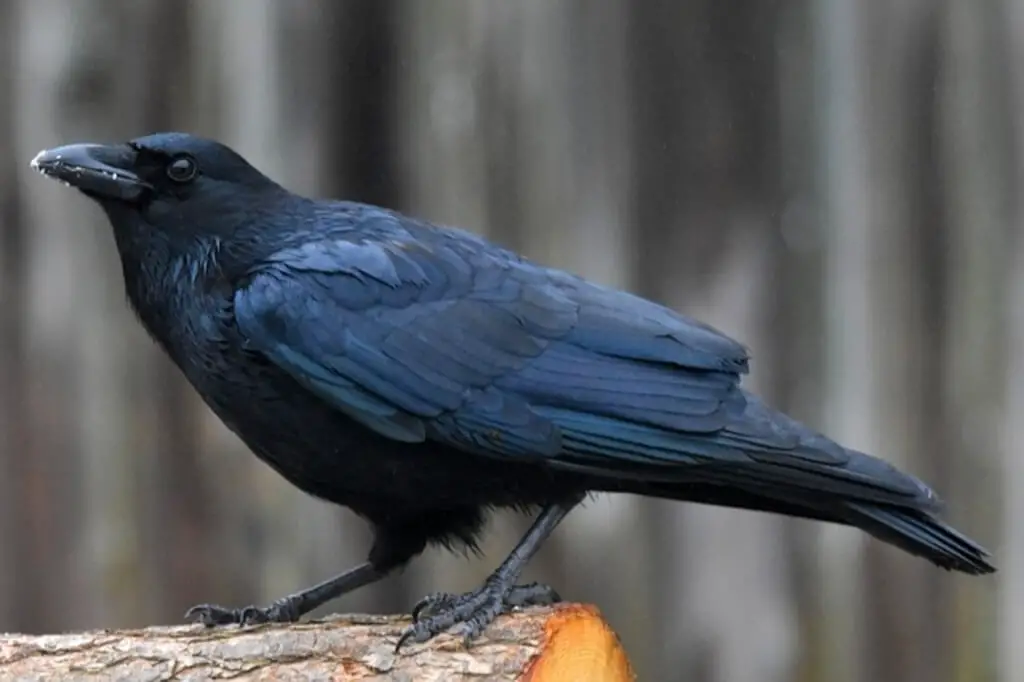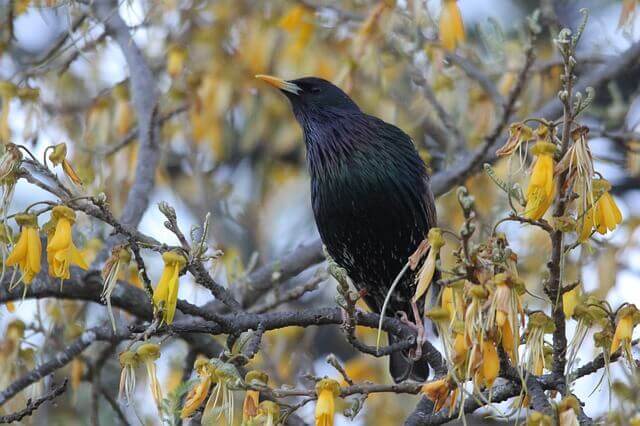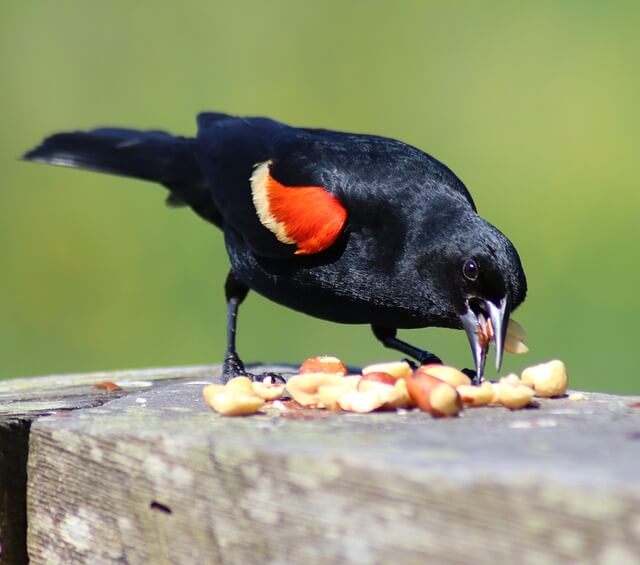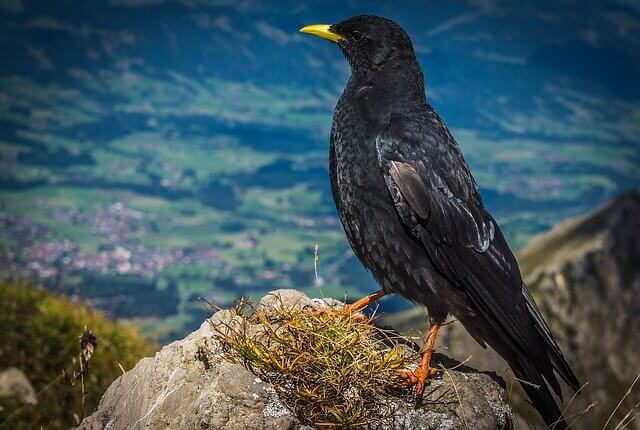Have you ever spotted a bird that resembles a crow, only to realize it’s not? Crows share their bold, dark features with many other species. From ravens to blackbirds, several birds closely resemble crows. In this article, we’ll dive into 16 birds that look like crows and help you spot the key differences to make a proper identification.
Table of Contents
- 1 American Crow (Overview)
- 2 Birds That Look Like Crows But Aren’t
- 2.1 European Starlings
- 2.2 Common Raven
- 2.3 Brewer’s Blackbird
- 2.4 Red-winged Blackbird
- 2.5 Common Grackle
- 2.6 Great-tailed Grackle
- 2.7 Brown-headed Cowbird
- 2.8 Jackdaw
- 2.9 Currawong
- 2.10 Rook
- 2.11 Northwestern Crow
- 2.12 Fish Crow
- 2.13 Chihuahuan Raven
- 2.14 Black-billed Magpies
- 2.15 Yellow-billed Chough
- 2.16 Clark’s Nutcracker
- 3 Frequently Asked Questions
- 4 Conclusion
- 5 Author
American Crow (Overview)

Crows are fascinating birds that have captured the imaginations of people all around the world. With their jet-black feathers and piercing gaze, crows are a common sight in many urban and rural environments, but there is much more to these birds than meets the eye. Let’s take a closer look at some of the key aspects of crow biology and behavior.
Appearance
Crows are large birds, typically measuring around 17 to 21 inches in length and weighing up to a pound or more. They have black feathers all over their bodies, including their wings, which have a distinct sheen in the sunlight. Crows have sharp, pointed bills and strong, curved talons, which they use to capture and manipulate food items.
Behavior
Crows are highly intelligent birds with complex social lives. They are known to form close bonds with family members and other members of their social group, and they use a wide range of vocalizations to communicate with each other.
Crows are also opportunistic feeders, meaning that they will eat a wide variety of foods, including insects, fruits, seeds, small animals, and even carrion.
Habitat
Crows are found in a wide variety of habitats, from dense forests to urban parks. They are particularly common in areas where there are plenty of food sources and roosting sites, such as around garbage dumps or along the edges of fields and forests.
Ecological role
Crows play an important role in many ecosystems as scavengers and seed dispersers. They also help to control populations of small animals, such as insects and rodents, which can have a major impact on local plant and animal communities.
Why are crows often mistaken for other bird species?
Crows are often confused with other black birds, such as ravens, grackles, and blackbirds, because of their similar appearance. However, there are some key differences between these species that can help you tell them apart.
For example, crows are generally smaller and have a more rounded tail than ravens, while grackles have a distinctive iridescent sheen to their feathers. By paying attention to these details, you can become a pro at identifying crows and other black birds in no time!
Birds That Look Like Crows But Aren’t
European Starlings
European Starlings are medium-sized birds that resemble crows, they have shiny iridescent black plumage that is speckled with white, it has a black bill that changes to a yellow color in the summer, and pink legs. The European Starling is 20–25 cm (7.9–9.8 in) in length, and a weight of 65–105g (2.3–3.7 oz). These birds that were introduced to North America in the 1800s.
The birds migrated over from Europe and are now common across most of North America, with populations as far south as Florida and Texas. European Starlings prefer open habitats such as farmland, grasslands, savannas and forest edges. They often eat insects but will also feed on fruit when it is available, they can live up to 12 years in the wild or captivity.
Related: How To Attract European Starlings To Your Yard Fast?
Common Raven
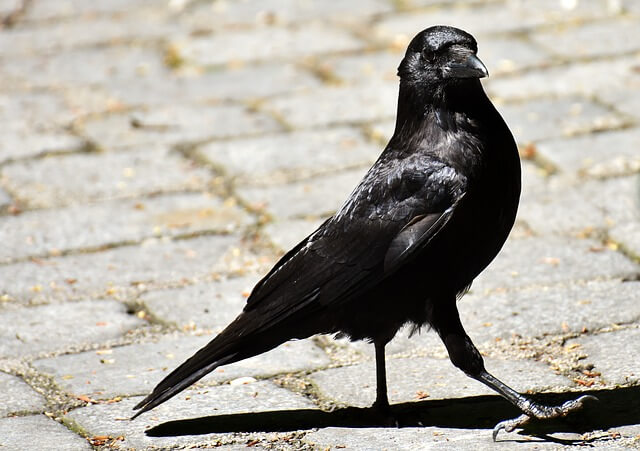
Ravens are one of the most distinctive birds in North America. In general, they are very large and entirely black just like crows. They can be found across the Northern Hemisphere with common ravens living in areas such as California, Alaska, Canada, Mexico and Scotland. Common Ravens are corvids, and are very similar to crows, with few major differences. Ravens have black feathers that are also more shiny than the crow’s feathers, and a heavier bill.
Another way to distinguish them from crows is by their much larger size, the ravens measure 63 cm (25 in) in length and 1.2 kg (2.6 lbs.) in weight, while crows only measure 34-40 cm (13-16 inches) in length and 0.4 kg (0.9 lbs.) in weight. Ravens can live more than 20 years in the wild, and commonly feed on carrion, insects, cereal grains, berries, fruit small animals nesting birds and food waste. Common ravens nest high up on cliffs or trees and may mate for life.
Related: 18 Fun Facts About Ravens That Will Amaze You
Brewer’s Blackbird
Brewer’s blackbirds are a common sight in open areas, near water. These birds have often been mistaken for crows because of their size and color. However, they are native to North America and can be found throughout the continent. Brewer’s blackbirds are often seen in groups of about six or seven, where males defend territories from other male Brewer’s blackbirds who try to intrude on their space. They also do not migrate south for the winter like many other birds do.
They’re known for their shiny iridescent black plumage, and a head and neck that is often described as being purple. This blackbird measures 8-10 inches (20-26 cm) in length, and weigh about 63 grams (2.2 oz). The Brewer’s blackbird has been observed to forage mostly on the ground in fields or near water, eating seeds, insects, berries. Their habitat is open and semi-open areas, across central and western North America.
Red-winged Blackbird
The red-winged blackbird is a migratory bird that has become an invasive species in the United States. It can be found across North America and Central America except for the southernmost parts like Mexico. The red-winged blackbird is all black just like the crow, and similar in size, except with a red shoulder and yellow wing bar, which it uses to identify each other during mating season.
They measure a length of 20–25 cm (8.7–9.4 in) and a weight of 65 g (2.3 oz). Its preferred habitat is open grassy areas, wetlands, marshes, meadows, prairies and fields. This type of environment provides food sources for these birds to eat as well as shelter. These birds are mainly seen on the ground foraging for food which includes seeds, corn and insects.
Common Grackle

The Common Grackle is the most charismatic bird native to North America. It has similar habits to crows, but they are larger, and measures from 30 to 35 cm (11 to 13 in) in length, and have an average weight of 75-140 g (2.6-5 oz). They are found throughout the United States except for Alaska, Montana, Nevada, Oregon, and Washington State.
The most distinctive feature of the common grackle is its purple iridescence on the head which contrasts with a metallic brown sheen in the body plumage, making it look black from afar but close up it becomes obvious that they are actually dark blue-black. Despite their flashy exterior, these birds are surprisingly elusive and can be difficult to spot among trees or tall grasses. Their habitat is open and semi-open areas such as cavities and man-made structures, forages on the ground, eats insects,
Great-tailed Grackle
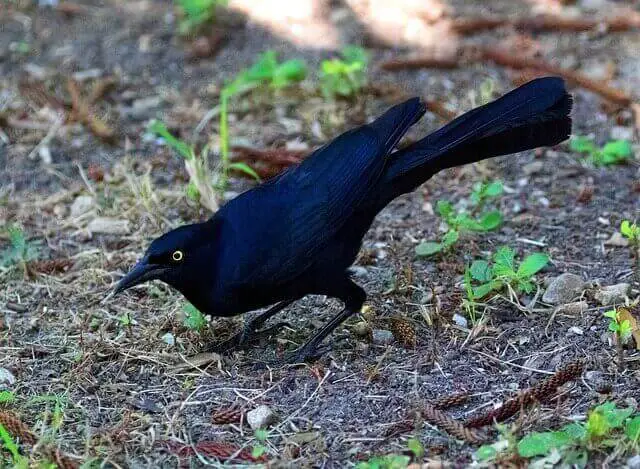
The Great-tailed Grackle is a bird that is often overlooked, even though it’s relatively common in North and South America. They are about the size of a crow, but they are iridescent black with a glossy purple-blue plumage throughout.
They eat fruits, berries, larvae, insects, lizards, nestlings and eggs which is why they forage on the ground in pastures, chaparral and wetlands where these food sources can be found. Great-tailed Grackle measure around 40-45 cm (15 in-18 in) in length, and weigh 200 g -265 g (7.2 oz)- (9.3 oz). The key word here is the ‘great’. That’s because they have a tail that measures up to 20 cm long!
Brown-headed Cowbird
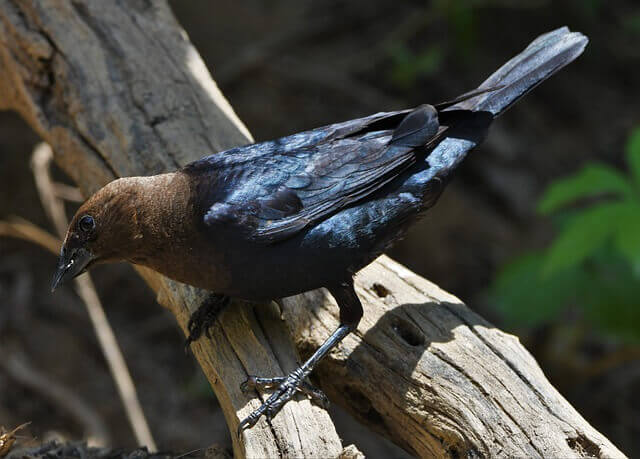
The Brown-headed Cowbird is a small bird native to mild, and equatorial regions in North America, and migrate to the southern United States and Mexico. These birds return to their summer habitat around the beginning of March to the end of April. Their diet mainly consists of eating seeds from grasses and weeds and insects such as beetles, flies, and grasshoppers.
Brown-headed Cowbirds are smaller than crows but have similar features, including iridescent black feathers with brown heads. This species of bird can be found in open or semi-open country habitats throughout North America. The length of this bird ranges from 16 to 25 cm (6.3–9.8 in) and weigh 30–60 g (1.1–2.0 oz).
Jackdaw
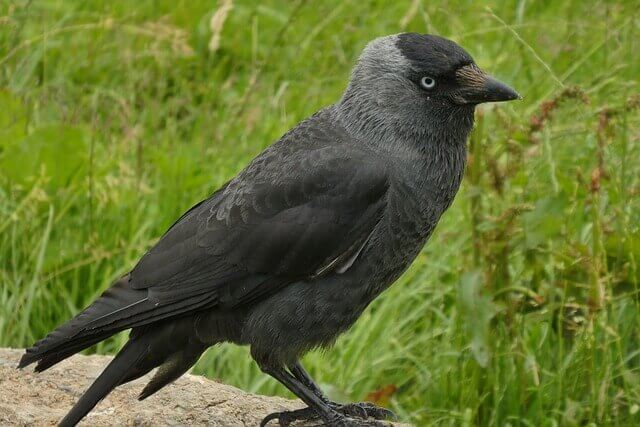
Western Jackdaws are crows, and like their cousins, they have an extensive vocabulary. They will call out warnings to each other if a predator is nearby. This small bird of prey is also known as the European jackdaw or just simply jackdaw. Western Jackdaws live in Western Europe, West Asia and North Africa.
In these regions they can be found on cultivated land, pastures and coastal cliffs foraging for food on the ground such as for beetles, flies, small invertebrates, berries, and plant material. They measure 35-40 cm in length and weigh about 240 grams. The overall plumage is glossy black on top with gray silver colored cheeks, neck and underparts.
Currawong
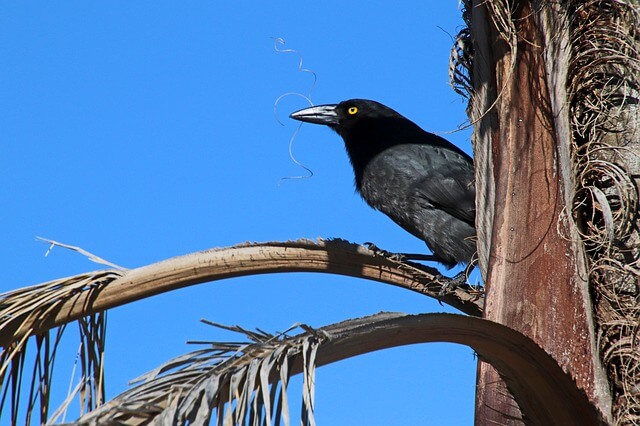
Currawongs are a species of Australian bird that are similar to crows in appearance, but have some key differences. Currawongs inhabit Eastern Australia forests, rural and semi-urban environments. They have a black plumage that resembles crows, although they are slimmer in build with longer tails and beaks.
Unlike the crow’s feathers which look like shiny obsidian, Currawong feathers appear as dark charcoal with a purple hue. The average size for these birds is around 44-55 cm (17-21.6 in) and weigh about 350 g (12.3 oz). Their food preference is insects, larvae, fruit, and bird nestlings. Currawongs usually live for about 10 years in the wild or up to 20 years in captivity.
Rook
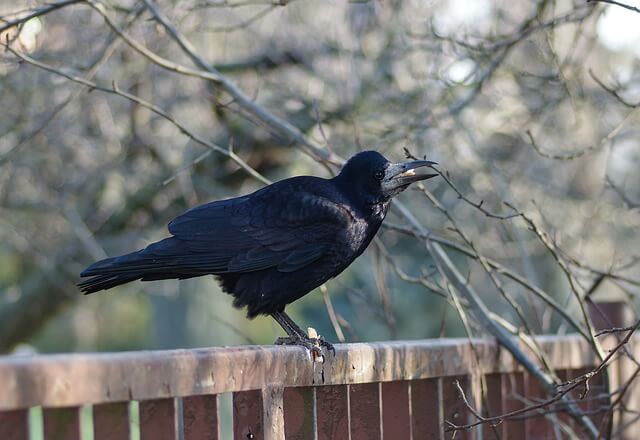
The Rook is a large bird from the crow family Corvidae, they have a black plumage that looks like bluish-purple gloss, their range is from Northern to Central Europe. These birds measure 45 cm (17.7 in) in length and weighing 285 to 340 g (10.5 to 12.0 oz).
They prefer open agricultural areas with pastures, and their food preferences are vegetable matter, insects, nuts and berries Rooks are found throughout Europe where they forage mostly on farms, garbage dumps, and garbage bins feeding on human food scraps.
Northwestern Crow
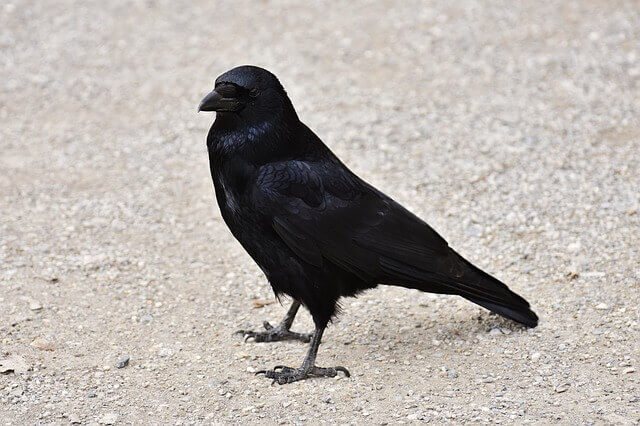
The Northwestern Crow (Corvus caurinus) is one of only two members of the Corvidae family to live exclusively on the west coast. Northwestern Crows are found from northern California to Alaska in northwestern North America. The other being their close relative, the American Crow (Corvus brachyrhynchos).
The Northwestern Crow is an almost identical subspecies of the crow but a bit smaller and have a bigger voice, they are often seen in suburban areas and coastal habitats of the Pacific Northwest, like river edges, tidal flats. They eat fish, shellfish, crabs, mussels, insects, invertebrates and fruits. They have a length of 16.5-17.5 in (41.9-45 cm) Weight: 14-16 oz (390-445g).
Fish Crow
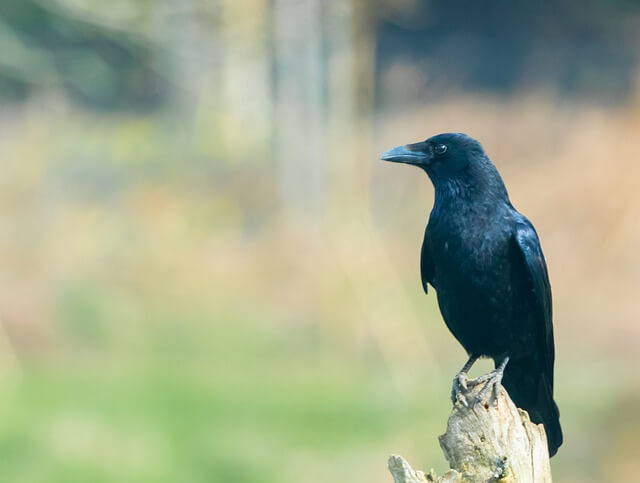
The Fish Crow is a small member of the crow family. They are found in wetland habitats throughout the eastern and southeastern United States. These birds are smaller than their more well-known cousin, the American Crow, with an average length of 12-16 inches (36–41 cm) and weight of 12-15 oz. (340 – 425 grams).
The Fish Crow has a bluish green gloss on its upper parts and underparts that can be either greenish black or brownish gray. Their habitat includes marshes, river banks, lakes, and beaches where they feed on reptiles, small crustaceans, invertebrates, fish, human scraps, fruits, grains and peanuts.
Chihuahuan Raven
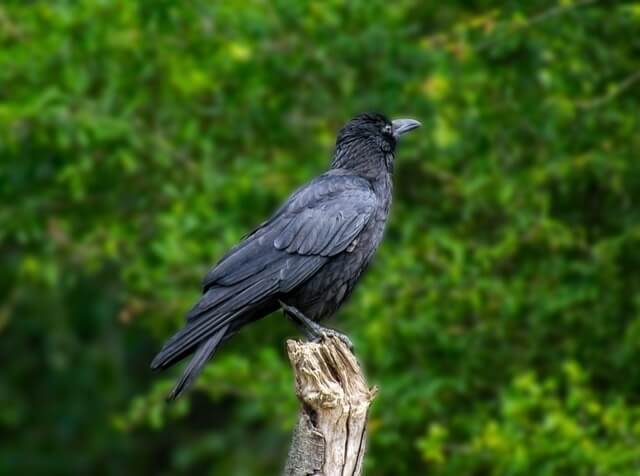
The Chihuahuan Raven is a species of crow in the family Corvidae. The Chihuahuan raven has been seen as far north as Arizona and Texas, with a range that extends into Mexico. These birds can be found on dry, open grasslands with trees and shrubs, desert scrub where they are primarily eats insects, grains, invertebrates, carrion (dead animals), small reptiles, prickly pears, eggs and small nestlings.
Chihuahuan Ravens have the same characteristics as the American Crow just slightly bigger measuring (45-50 cm) 17.7 -19.5″ in length with a weight of 530 grams. Their plumage similar to the crow, and is all black with a purple and blue sheen.
Related: 18 Fun Facts About Ravens That Will Amaze You
Black-billed Magpies
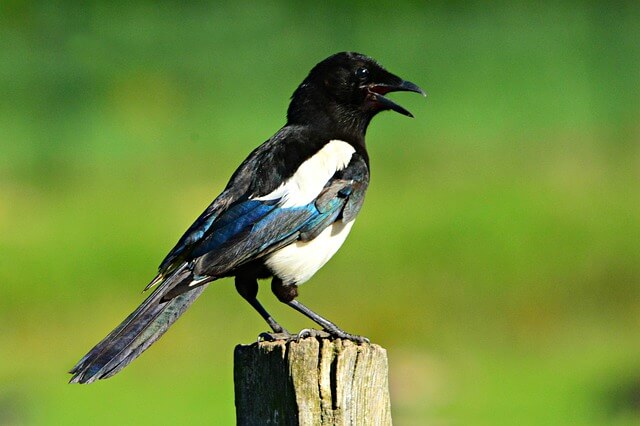
Magpies are a bird species of the crow family Corvidae, found in milder regions in the western half of North America.They are most common west of Texas and north into Oregon and Washington, but they have been spotted as far east as Nebraska and Iowa. These birds are black and white, and have an iridescent blue tinge. It can be seen at forest edges and clearings within pine forests, scrublands, chaparral brushland, mixed farmlands shrubs, conifer trees, deciduous trees, orchards, vineyards as well as city parks.
They measure 45–60 cm (18–24 in) and weigh 160–215 grams (5.6–7.6 oz). The magpies are gregarious and omnivorous, feeding on seeds, berries, insects, carrion (dead animals), small rodents like mice or rats (these make up less than 10% of the bird’s diet).
Related: How to Attract Magpies to your Garden? (In 4 Easy Steps!)
Yellow-billed Chough
The Yellow-billed chough is a bird in the crow family, and it can be found on mountains and coastal cliffs all over Europe, North Africa, China, Asia, India. It has distinctive black plumage with an yellow bill that features deep indentations near the tip of its bill. They are not very large birds: adults have a body length between 22-26 inches (55-65 cm) and weigh about 1 pound (.5 kg).
This fascinating creature has many physical characteristics that make it stand out from other birds. It is smaller than crows or ravens with a short tail and curved beak but larger than jackdaws or magpies. The species is highly gregarious outside of breeding season and forms large flocks. It feeds mainly on insects and as an opportunist will also eat scraps from human habitation.
Clark’s Nutcracker
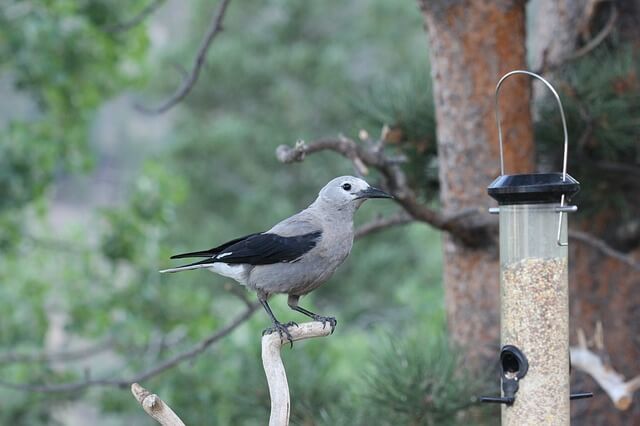
The Clark’s nutcracker is a bird native to the mountains of western North America of the corvid family. They are often found in high altitude pine forests, and can be identified by their red eyes and grayish-white body, with black on its wings. Their diet consists mainly of pine nuts, which they find from breaking open pine cones or digging into the bark of trees.
They have been observed eating insects, small mammals, berries and even flowers at times. These birds are an important part of many ecosystems because they help disperse seeds across wide areas when feeding at lower elevations.
Frequently Asked Questions
What bird looks like a crow but is larger?
The Common Raven is a medium-sized bird that resembles a crow, but is larger. It can be seen in North America, Europe, and Asia. The Common Raven is black with a glossy sheen. It has a wingspan of up to five feet and can weigh up to three and a half pounds. The Common Raven is known for its intelligence and its ability to imitate other birds and animals.
Do starlings look like crows?
Yes they do, but the difference is that crows are slightly larger, and have a black plumage while starlings have an iridescent plumage. Although they may look alike, these two birds are not related. The crow is a member of the Corvidae family, which includes ravens, jays and magpies. The starling is a member of the Sturnidae family, which includes mynas and grackles.
How can you tell a starling?
The common starling, also known as the European starling, is a stocky bird that is about 20 cm. in length with a purplish-green iridescent plumage and a glossy sheen. Additionally, you can look for the pink legs and the black bill in winter or the yellow bill in summer.
What does it mean when a starling visits you?
Starling visits have been considered lucky omens by many cultures throughout history. In some Native American traditions, seeing a starling means that good news is on the way. In some cultures, the starling may also symbolize unity.
Conclusion
As we come to the end of this avian adventure, it’s crucial to remember the main takeaway: distinguishing between similar bird species is vital. While it may be easy to mistake a grackle or a raven for a crow, the subtle differences can have a significant impact on our understanding of these amazing creatures.
We’ve covered 16 birds that look like crows, from the sleek and slender Fish Crow to the colorful and jolly Red-winged Blackbird. Each one has its unique features and characteristics that set it apart from our favorite corvid.
Related: How To Attract Crows To Your Backyard: Expert Tips!

